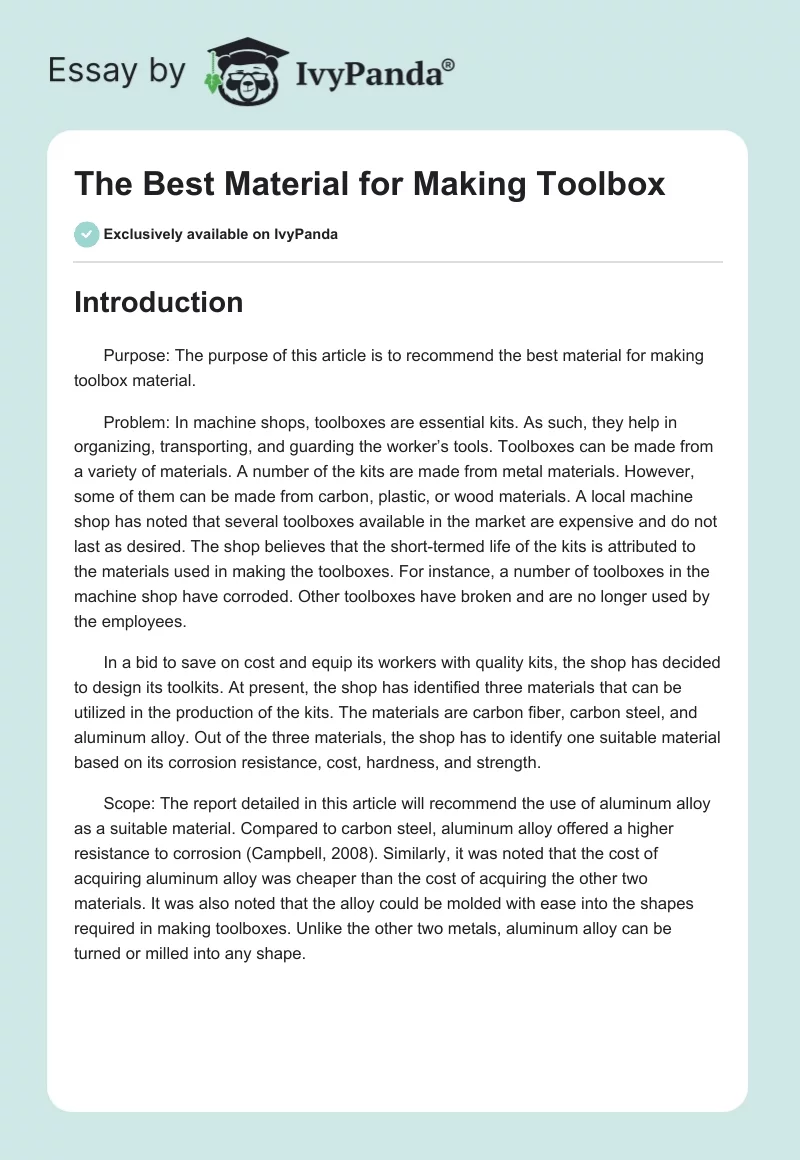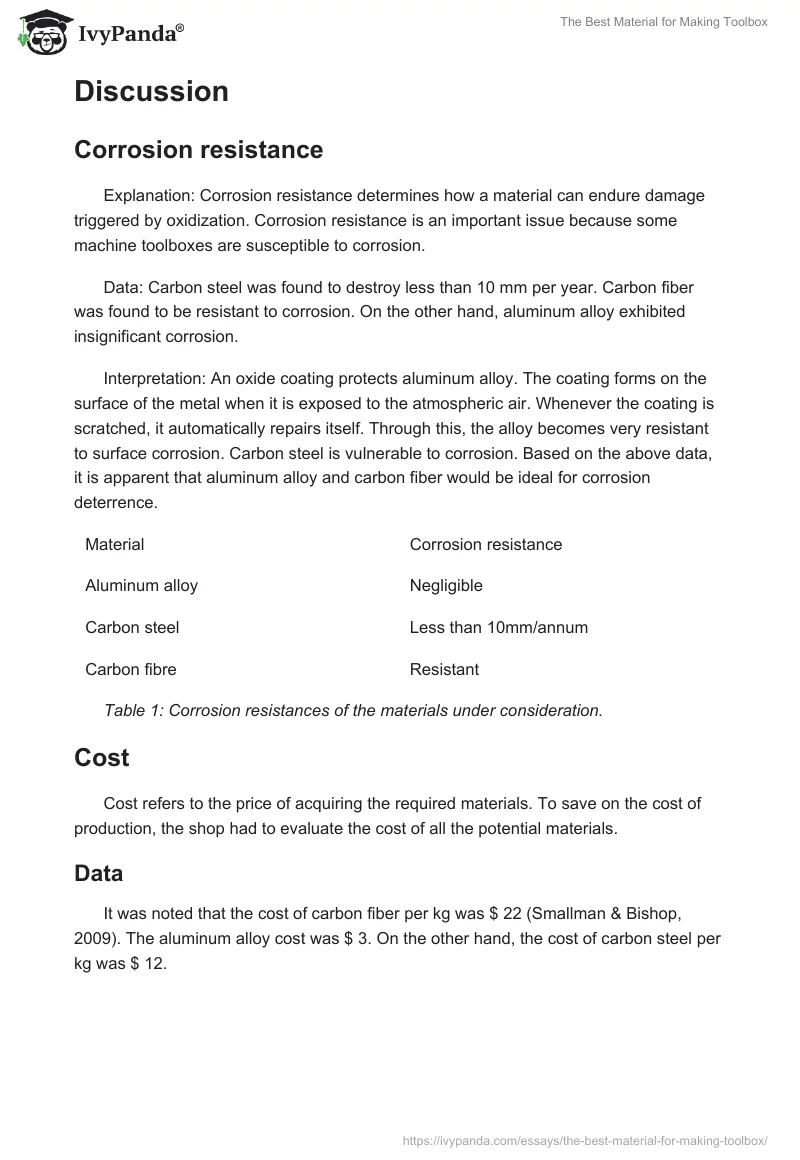Introduction
Purpose: The purpose of this article is to recommend the best material for making toolbox material.
Problem: In machine shops, toolboxes are essential kits. As such, they help in organizing, transporting, and guarding the worker’s tools. Toolboxes can be made from a variety of materials. A number of the kits are made from metal materials. However, some of them can be made from carbon, plastic, or wood materials. A local machine shop has noted that several toolboxes available in the market are expensive and do not last as desired. The shop believes that the short-termed life of the kits is attributed to the materials used in making the toolboxes. For instance, a number of toolboxes in the machine shop have corroded. Other toolboxes have broken and are no longer used by the employees.
In a bid to save on cost and equip its workers with quality kits, the shop has decided to design its toolkits. At present, the shop has identified three materials that can be utilized in the production of the kits. The materials are carbon fiber, carbon steel, and aluminum alloy. Out of the three materials, the shop has to identify one suitable material based on its corrosion resistance, cost, hardness, and strength.
Scope: The report detailed in this article will recommend the use of aluminum alloy as a suitable material. Compared to carbon steel, aluminum alloy offered a higher resistance to corrosion (Campbell, 2008). Similarly, it was noted that the cost of acquiring aluminum alloy was cheaper than the cost of acquiring the other two materials. It was also noted that the alloy could be molded with ease into the shapes required in making toolboxes. Unlike the other two metals, aluminum alloy can be turned or milled into any shape.
Discussion
Corrosion resistance
Explanation: Corrosion resistance determines how a material can endure damage triggered by oxidization. Corrosion resistance is an important issue because some machine toolboxes are susceptible to corrosion.
Data: Carbon steel was found to destroy less than 10 mm per year. Carbon fiber was found to be resistant to corrosion. On the other hand, aluminum alloy exhibited insignificant corrosion.
Interpretation: An oxide coating protects aluminum alloy. The coating forms on the surface of the metal when it is exposed to the atmospheric air. Whenever the coating is scratched, it automatically repairs itself. Through this, the alloy becomes very resistant to surface corrosion. Carbon steel is vulnerable to corrosion. Based on the above data, it is apparent that aluminum alloy and carbon fiber would be ideal for corrosion deterrence.
Table 1: Corrosion resistances of the materials under consideration.
Cost
Cost refers to the price of acquiring the required materials. To save on the cost of production, the shop had to evaluate the cost of all the potential materials.
Data
It was noted that the cost of carbon fiber per kg was $ 22 (Smallman & Bishop, 2009). The aluminum alloy cost was $ 3. On the other hand, the cost of carbon steel per kg was $ 12.
Interpretation
Concerning the above data, it is clear that the shop will select aluminum as its preferred toolbox material. The shop will be able to save on its operation cost by selecting the material without compromising on the quality of the toolboxes.
Table 2: cost of the materials under consideration.
Hardness and strength
Explanation: Hardness and strength refers to the capability of a substance to sustain breakage under a sustained force. With respect to the machine shop, the hardness and strength of the material is significant to prevent damage from tools and machinery.
Data: The tensile strength of aluminum alloy was found to be 124 MPa (Jindal, 2012). The tensile strength of carbon steel was found to be 620 MPa. On the other hand, the tensile strength of carbon fibre was found to be 4000 MPa.
Table 3: Tensile strengths of the materials under consideration.
Interpretation: Carbon fibre is the strongest material of all the three options. Aluminum and carbon steel are steel strong enough to prevent damage from the machinery and tools. In this respect, all the three materials can be used in making toolboxes.
Conclusion
This report analyzed aluminum alloy, carbon fiber, and carbon steel as potential toolbox material. The materials were analyzed based on corrosion resistance, strength, hardness, and costs. As noted in the illustrations above, all materials have advantages and disadvantages. Compared to carbon steel, aluminum alloy offered a higher resistance to corrosion. Similarly, it was noted that the cost of acquiring aluminum alloy was cheaper than the cost of acquiring the other two materials. It was also noted that the alloy could be molded with ease into the shapes required in making toolboxes.
Recommendation: the report recommends the use of aluminum alloy for making toolbox material.
References
Campbell, F. (2008). Elements of metallurgy and engineering alloys. Materials Park, Ohio: ASM International. Web.
Jindal, U. (2012). Material science and metallurgy. New Delhi: Dorling Kindersley. Web.
Smallman, R., & Bishop, R. (2009). Modern physical metallurgy and materials engineering science, process, applications. (6th ed.). Oxford: Butterworth Heinemann. Web.


